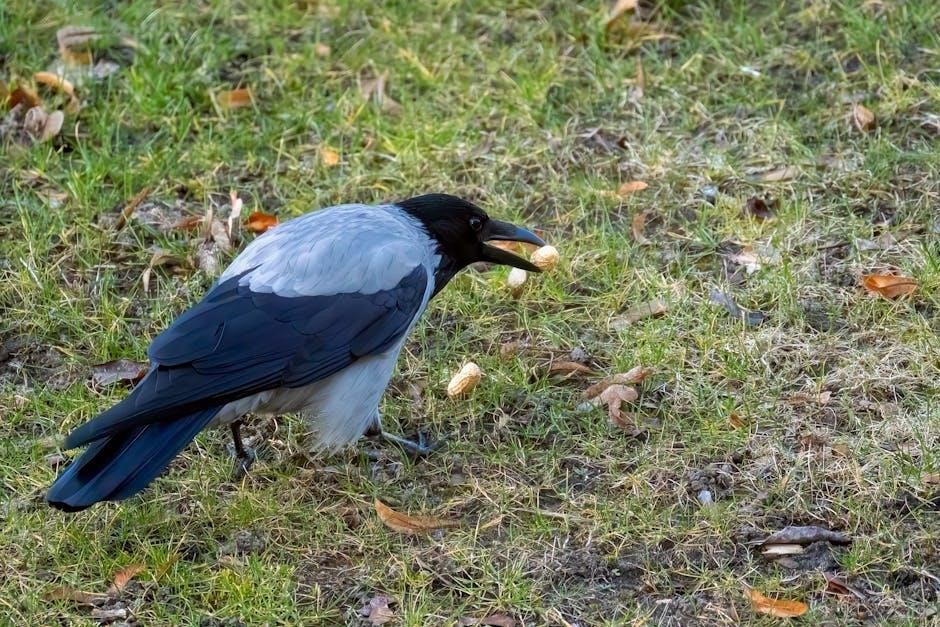
smart bird feeder instructions
Smart bird feeders revolutionize bird-watching by integrating cameras and AI for species identification, offering real-time monitoring and educational insights for nature enthusiasts and birders alike.
What is a Smart Bird Feeder?
A smart bird feeder is an innovative device designed to enhance bird-watching experiences. Equipped with cameras, AI technology, and Wi-Fi connectivity, it captures images or videos of birds, identifies species, and sends alerts to your smartphone. These feeders often include motion sensors, cloud storage for recordings, and app-controlled settings. They are typically solar-powered or battery-operated, offering a user-friendly and eco-friendly way to monitor bird activity remotely. This technology bridges nature observation with modern convenience, making it a must-have for bird enthusiasts and researchers alike.
Benefits of Using a Smart Bird Feeder
A smart bird feeder enhances bird-watching experiences by providing real-time monitoring, species identification, and educational insights. It allows users to capture high-quality images or videos, receive alerts when birds visit, and access species information through AI-powered recognition. The feeder’s app connectivity enables remote monitoring, reducing the need for physical presence, which minimizes habitat disturbance. Additionally, cloud storage lets users review and share sightings, fostering a sense of community among birders. This technology makes bird-watching more engaging, convenient, and environmentally friendly.
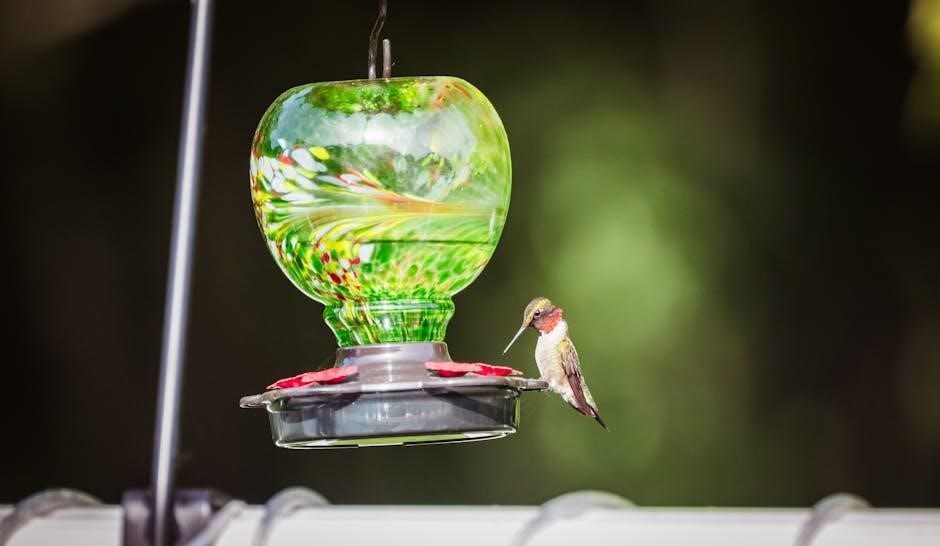
Key Features of Smart Bird Feeders
Smart bird feeders feature integrated cameras, Wi-Fi connectivity, motion sensors, and cloud storage, enabling remote monitoring, bird recognition, and video recording for enhanced bird-watching experiences.
Integrated Camera for Bird Recognition
The integrated camera in smart bird feeders captures high-quality images or video of visiting birds, enabling AI-powered recognition systems to identify species accurately. This feature allows users to learn about different bird types and their behaviors. Motion detection triggers the camera to record footage, which is often stored in the cloud for later viewing. Alerts can be sent to smartphones when a new species is detected, enhancing the overall bird-watching experience. This technology bridges entertainment and education, making it easier for enthusiasts to engage with wildlife.
Wi-Fi Connectivity and App Control
Smart bird feeders utilize Wi-Fi connectivity to link with dedicated apps, allowing users to monitor bird activity remotely. Through the app, users can adjust camera settings, receive notifications for bird sightings, and access recorded videos. Connectivity issues can sometimes occur, but troubleshooting steps like resetting the feeder or checking network stability often resolve these problems. Ensuring a stable internet connection is crucial for seamless app performance and real-time updates, enhancing the overall user experience with smart bird feeders.
motion-Activated Sensors
Motion-Activated Sensors
Motion-activated sensors in smart bird feeders detect movement, triggering camera recording and alerts. These sensors minimize unnecessary footage, focusing only on bird activity. Adjust sensitivity to avoid false triggers from wind or small animals. Customizable settings allow users to tailor detection to specific bird species or activity levels. Notifications are sent to your smartphone when motion is detected, ensuring you never miss a bird visit. This feature enhances monitoring and helps deter pests by alerting you to unwanted visitors, making it a valuable tool for bird enthusiasts. Sensors also reduce storage usage by recording only when needed.
Cloud Storage for Bird Sightings
Cloud storage on smart bird feeders automatically saves video recordings of bird visits, accessed remotely through the app. This feature ensures your bird sightings are securely stored and organized. Videos are timestamped and categorized, allowing easy browsing. Cloud storage also enables sharing bird encounters with online communities. The system often provides a limited free storage capacity, with options to upgrade for more space. This feature eliminates the need for an SD card and ensures your bird-watching memories are preserved and easily accessible for future reference or contribution to citizen science projects.
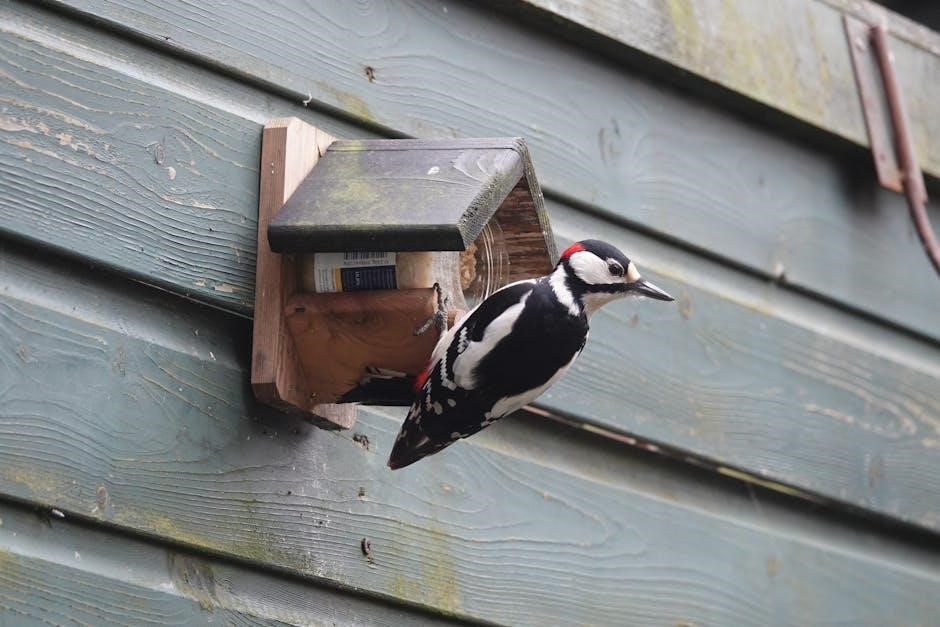
Unboxing and Assembly
Unbox and inventory all components, including the feeder, camera, and mounting hardware; Follow step-by-step assembly instructions to attach the antenna and secure the feeder for installation.
Unpacking the Components
Begin by carefully unboxing the smart bird feeder and its accessories. Typically, the package includes the feeder unit, an integrated camera, mounting hardware, an antenna, and an instruction manual. Ensure all components are accounted for before proceeding. Gently remove the feeder from its packaging and inspect for any damage; Locate the antenna, which is essential for Wi-Fi connectivity, and prepare it for installation. Some models may also include additional accessories like screws or an SD card, though the latter is often optional. Store all packaging materials safely until assembly is complete.
Step-by-Step Assembly Instructions
Begin by attaching the antenna to the feeder’s base. Insert the antenna into the designated hole on the back of the seed container and twist it firmly to secure it. Next, assemble the base by aligning the feeder’s bottom panel with the base unit and snapping it into place. Attach the feeder cover by aligning the tabs and gently pressing down until it clicks. Finally, mount the feeder by screwing it onto a wall or pole, ensuring it is level for proper seed distribution. Follow these steps carefully to ensure a stable and functional setup.
Attaching the Antenna for Proper Connectivity
Locate the antenna port on the back of the bird feeder. Insert the antenna into the port and twist it gently until it clicks securely into place. Ensure the antenna is straight and not bent to maintain optimal connectivity. If the antenna is loose or improperly attached, the app may fail to connect to the feeder. To verify connectivity, open the app and check for a stable connection. Periodically inspect the antenna to ensure it remains tightly fastened for reliable Wi-Fi performance and uninterrupted bird monitoring.
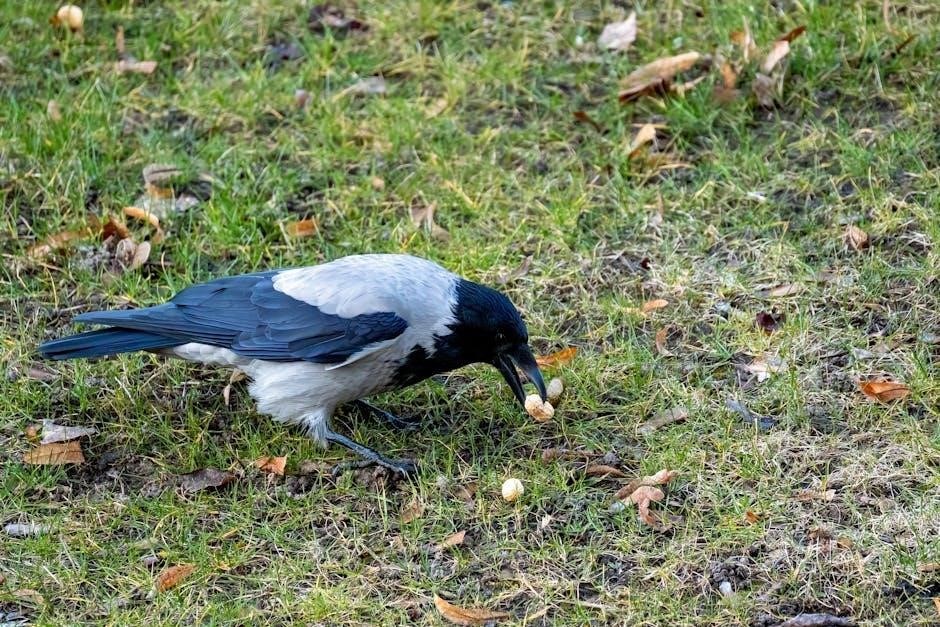
Setting Up the Smart Bird Feeder App
Download the app from the App Store or Google Play, register an account, and connect your feeder to the app for real-time monitoring and control.
Downloading and Installing the App
To begin, visit the App Store (for iOS) or Google Play Store (for Android) and search for the specific app associated with your smart bird feeder, such as “Bird Buddy” or “HiBirds.” Once found, download and install the app. Ensure the app is from the official developer to avoid counterfeit versions. After installation, open the app and proceed to the next steps for account creation and device connectivity. This setup is essential for unlocking all the smart features of your bird feeder.
Creating an Account for App Access
After downloading the app, launch it and create an account to access all features. Tap “Register” and follow the in-app instructions to sign up using your mobile number or email. This account will link your smart bird feeder to the app, enabling features like bird recognition and alerts. Ensure your device is connected to a stable Wi-Fi network for seamless registration. If you encounter connectivity issues, check the antenna connection and ensure proper Wi-Fi setup before proceeding.
Connecting the Feeder to Your Smartphone
Once the app is installed, open it and log in using your newly created account. Ensure your smartphone is connected to a stable Wi-Fi network. Locate the QR code on the feeder’s packaging or manual and scan it within the app to establish a connection. Follow the on-screen instructions to complete the pairing process. If prompted, enter the Wi-Fi password for your network. Ensure the feeder’s antenna is securely attached for optimal connectivity. Once connected, you’ll receive a confirmation message, and the feeder will be synced with your smartphone.
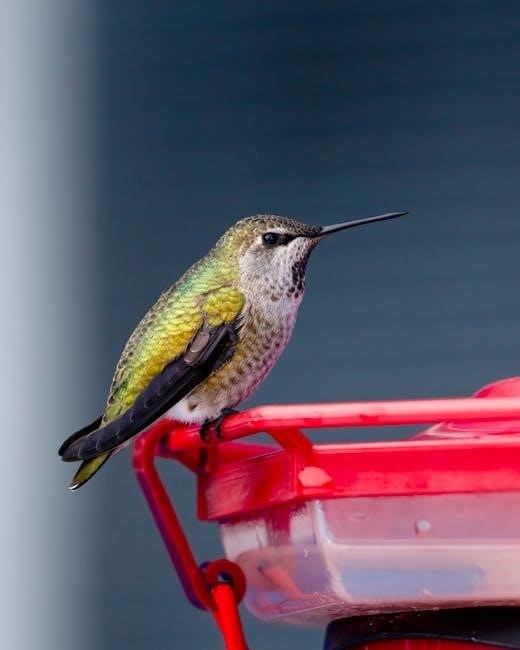
Installing the Bird Feeder
Installing the bird feeder involves selecting a prime location, securely mounting it on a wall or pole, and powering it via battery or solar energy.
Choosing the Best Location for the Feeder
Position the smart bird feeder in an area with high bird traffic, such as near trees or shrubs, to maximize visibility. Ensure it’s placed at least 3-5 feet off the ground to deter pests. Install it near a window for easy viewing but avoid direct sunlight to prevent overheating. Choose a spot with good natural light for optimal camera performance. Ensure the feeder is sheltered from strong winds and rain. Proper placement ensures better bird attraction and clearer video recordings for identification and monitoring.
Mounting the Feeder on a Wall or Pole
To mount the smart bird feeder, use the included screws or brackets to secure it to a wall or pole. Ensure the surface is sturdy and level for stability. Position the feeder at a height of 3-5 feet to prevent pests like raccoons from accessing it. Align the camera for an optimal viewing angle, and make sure the antenna is securely attached for proper connectivity. After mounting, double-check the camera angle and feeder alignment to ensure birds can easily access the feed while maintaining clear video recording capabilities.
Powering the Feeder (Battery or Solar)
Your smart bird feeder can be powered using a rechargeable battery or solar energy for convenient operation. For battery use, insert the provided rechargeable battery and charge it via USB-C before first use. Alternatively, attach the solar panel to harness renewable energy, ensuring the panel faces direct sunlight for optimal charging. Check the power level through the app and recharge as needed. Solar power is eco-friendly and reduces battery replacements, while battery power offers flexibility in shaded areas. Both options ensure continuous operation for bird monitoring and recording.
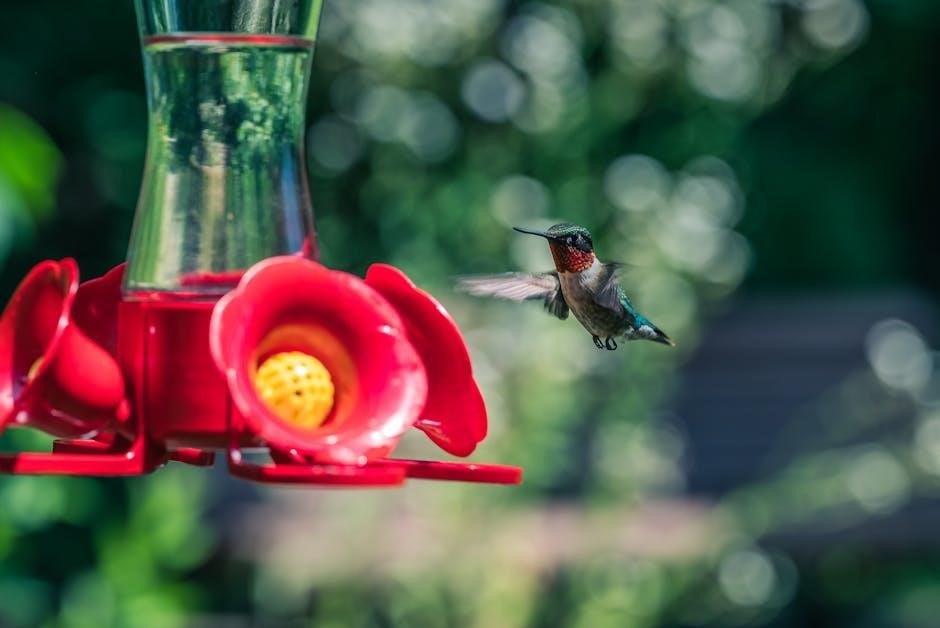
Configuring the Camera Settings
Adjust the camera angle for optimal bird viewing and enable motion detection. Set up video recording preferences and ensure proper cloud storage settings for bird activity monitoring.
Adjusting the Camera Angle for Optimal Viewing
To ensure the best bird-watching experience, adjust the camera angle by gently rotating or tilting it to capture the feeding area clearly. Use the app to preview the live feed and fine-tune the position for an unobstructed view. Make sure the lens is clean and free from obstructions. If needed, use the mounting bracket to reposition the camera for better coverage. Proper alignment ensures high-quality video and photo capture of visiting birds, enhancing your bird recognition and monitoring experience.
Enabling Motion Detection and Alerts
To enable motion detection, open the app and navigate to the settings menu. Toggle on the motion detection feature to activate the sensor. Adjust sensitivity levels to minimize false alerts from wind or small animals. Once enabled, the camera will detect movement and trigger alerts to your smartphone. These alerts often include a preview image or short video clip. The system uses AI to recognize birds and notify you of species sightings, ensuring you never miss a visit to your feeder. Customize alert settings to focus on specific bird species or activity levels for a tailored experience.
Setting Up Video Recording and Storage
Open the app and go to the camera settings menu to enable video recording. Choose between continuous recording or motion-triggered clips. Select the video quality and duration, such as 30-second or 1-minute clips. Opt for cloud storage or insert a microSD card for local storage. Ensure the camera angle is adjusted for optimal footage capture. Review and manage recorded videos through the app, deleting or downloading as needed. Adjust settings to balance storage capacity and video quality for seamless bird-watching experiences.
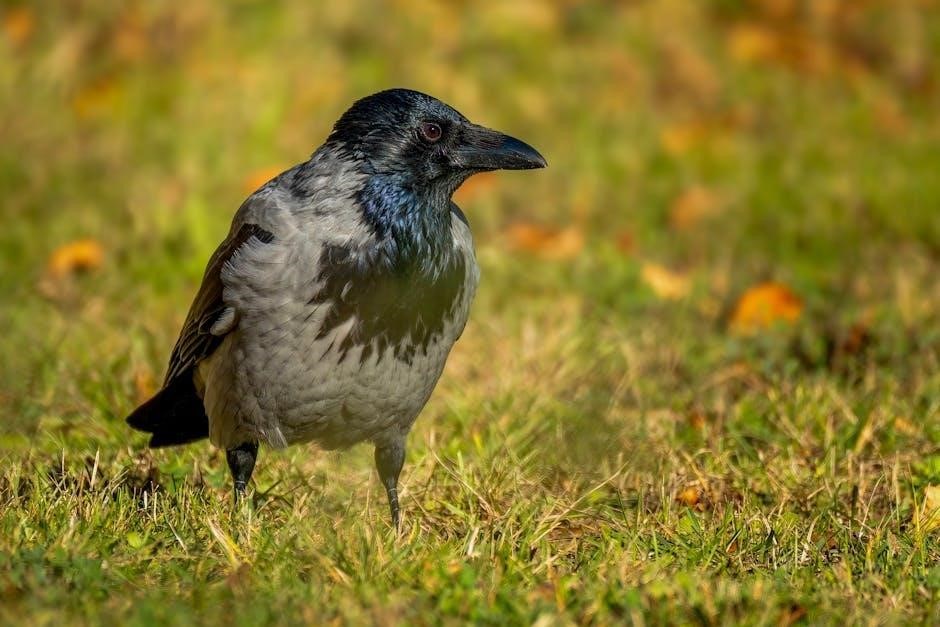
Maintenance and Troubleshooting
Regularly clean the feeder and camera lens to ensure proper function. Check Wi-Fi connectivity if issues arise. Update the app and firmware for optimal performance.
Cleaning the Feeder and Camera Lens
Regular cleaning ensures optimal performance and longevity of your smart bird feeder. Use a mild detergent and water to wipe down the feeder, avoiding harsh chemicals. Rinse thoroughly and dry with a soft cloth to prevent water spots. For the camera lens, gently clean with a microfiber cloth to remove smudges or debris. Avoid touching the lens to prevent oil residue. Clean the feeder every 1-2 weeks, or more frequently in wet or humid climates. This maintenance ensures clear video quality and proper bird recognition functionality.
Troubleshooting Connectivity Issues
If your smart bird feeder disconnects, start by ensuring the antenna is securely attached and properly aligned. Restart the feeder and your Wi-Fi router. Check the app for firmware updates and install the latest version. If issues persist, reset the feeder by pressing the reset button for 5 seconds. Ensure your smartphone is connected to the same Wi-Fi network as the feeder. If problems continue, refer to the user manual or contact customer support for further assistance. Regularly updating the app and firmware helps maintain stable connectivity.
Updating the App and Firmware
Regularly updating the app and firmware ensures optimal performance of your smart bird feeder. Open the app, navigate to the settings menu, and check for updates. Download and install the latest version to access new features and bug fixes. For firmware updates, follow the in-app instructions to ensure the feeder’s software is current. Keep the feeder connected to a stable internet connection during updates. Updating enhances functionality, improves security, and ensures compatibility with your smartphone. Always complete the update process fully to avoid system issues.
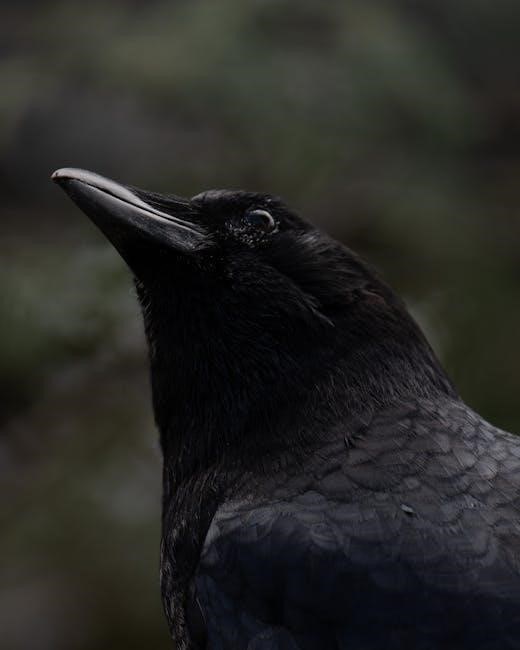
Using the Cloud Storage Feature
The cloud storage feature automatically saves bird sightings and videos, allowing users to access and view recordings anytime. Notifications alert you to new saved content.
Accessing and Viewing Recorded Videos
To access recorded videos, open the app and navigate to the “Cloud Events” section. Here, you’ll find all captured bird sightings organized by date and time. Each video is accompanied by AI-identified species information. Notifications alert you to new recordings, ensuring you never miss a moment. Videos are stored securely in the cloud, allowing easy viewing on your smartphone. For optimal storage management, you can delete or download videos directly from the app. This feature enhances your bird-watching experience by providing a convenient way to revisit and share memorable bird encounters.
Managing Cloud Storage Space
Your smart bird feeder app allows you to manage cloud storage efficiently. Videos are automatically stored in the cloud, but you can adjust settings to optimize space. Options include setting video quality, enabling auto-deletion of old recordings, or limiting storage capacity. Additionally, you can download favorite clips to your device for permanent keeping. An optional SD card slot provides local backup, reducing reliance on cloud storage if preferred. Regularly reviewing and deleting unused videos ensures your storage remains organized and within limits while preserving your most memorable bird sightings.
Sharing Bird Sightings with the Community
Smart bird feeders enable you to share your bird sightings with a community of wildlife enthusiasts. Through the app, you can upload recorded videos and photos to a shared platform, allowing others to view and learn from your observations. Many apps also provide species information and insights, making it easier to educate others about the birds you’ve spotted. This feature fosters a sense of connection among birders and supports citizen science projects by contributing valuable data to wildlife studies. Sharing your sightings not only enhances your own experience but also helps others discover and appreciate bird diversity.
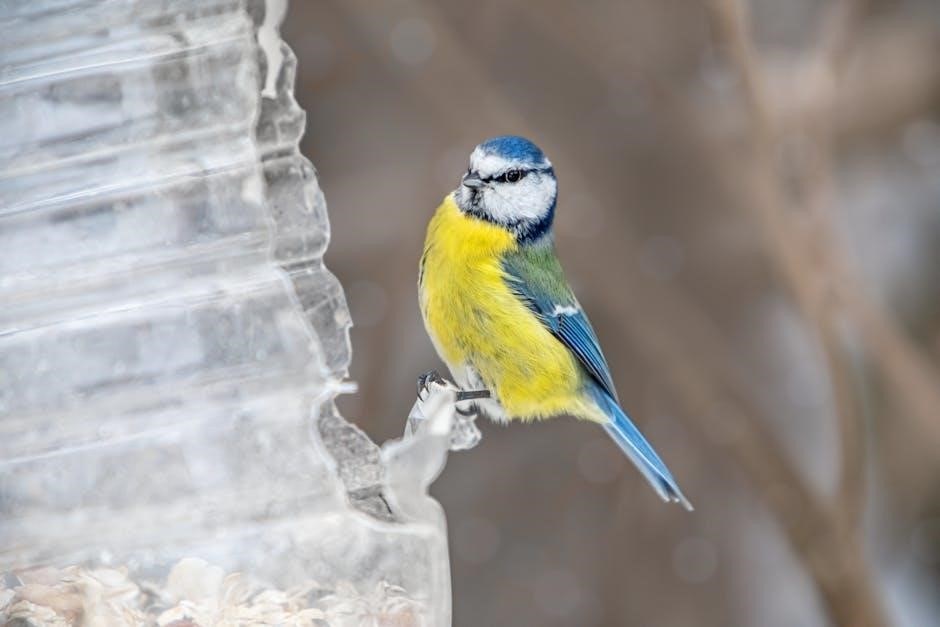
Bird Recognition and Identification
Smart bird feeders use AI to identify species, capturing and storing sightings in the cloud for later review, enhancing bird-watching experiences and educational opportunities for enthusiasts.
How the AI Recognition System Works
The AI recognition system in smart bird feeders uses a built-in camera to capture images or videos of visiting birds. These visuals are then analyzed using advanced algorithms to identify species. The process typically involves uploading the footage to the cloud, where AI compares the images against a vast database of bird species. Once identified, the system sends notifications to the user’s smartphone app, providing details about the bird, such as its name, habitat, and behavioral traits. This innovative technology enhances bird-watching by offering real-time insights and educational opportunities for enthusiasts.
Viewing Bird Species Information
Once the AI identifies a bird species, users can access detailed information through the app. This includes the bird’s name, habitat, size, and behavioral traits. The app often links to educational resources, such as descriptions of nesting habits or migratory patterns. Some systems even provide audio clips of bird calls, enhancing the learning experience. This feature is particularly useful for beginners, offering a comprehensive understanding of the birds visiting the feeder. It also allows users to track and learn about local wildlife effortlessly.
Contributing to Citizen Science Projects
Smart bird feeders enable users to contribute to citizen science initiatives by sharing bird sightings and data. The feeder’s AI and cloud storage automatically upload sightings to global databases, aiding researchers in tracking bird populations and migration patterns. This collaboration helps conservation efforts and provides valuable insights into bird behavior. Users can support scientific studies while enjoying their hobby, fostering a connection between bird enthusiasts and the scientific community. This feature makes bird-watching both enjoyable and impactful, contributing to a larger understanding of wildlife.
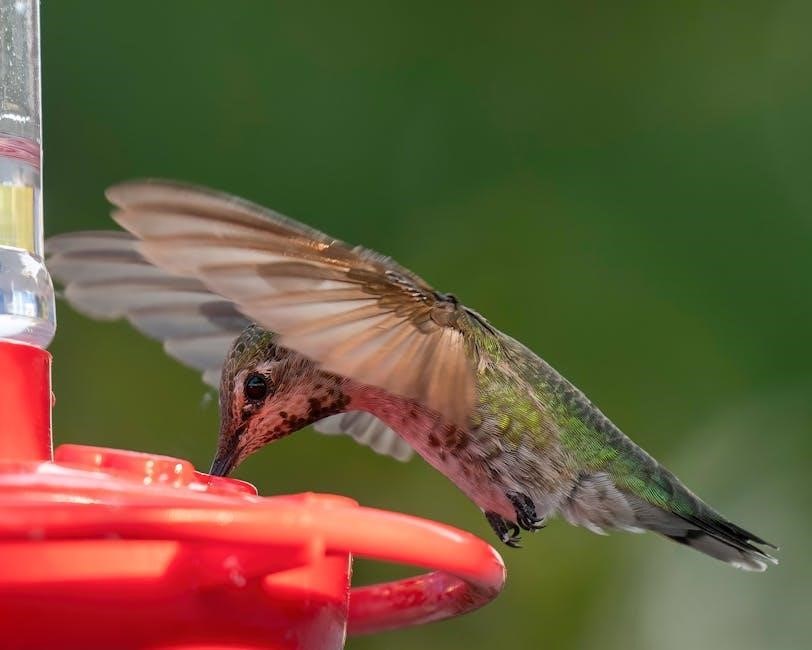
Attracting More Birds to Your Feeder
To attract more birds, offer a variety of seed types, ensure consistent food supply, and maintain a clean feeder. Provide water nearby and create a bird-friendly habitat with native plants and shelter to draw diverse species to your yard.
Choosing the Right Birdseed
Selecting the appropriate birdseed is crucial for attracting a variety of bird species. Sunflower seeds are popular among larger birds like cardinals and finches, while smaller birds prefer Nyjer or thistle seeds. Safflower seeds are a great alternative to sunflower seeds, as they deter squirrels. Mixed seed blends cater to diverse bird preferences, ensuring a wide range of species visit your feeder. Opt for high-quality, fresh seeds to avoid mold and ensure optimal nutrition. Avoid fillers like milo or wheat, as they are less favored by birds. Regularly rotating seed types can also attract different bird species and keep the feeder active. By offering the right seed, you create a welcoming environment for birds, enhancing your bird-watching experience.
Positioning the Feeder for Maximum Visibility
Position your smart bird feeder in an open area with good visibility to attract a variety of bird species. Place it 3-5 feet off the ground to protect birds from predators and ensure easy viewing. Locate it near shrubs or trees to provide birds with cover while feeding. Avoid placing it too close to structures to prevent squirrel access. Ensure the feeder faces a direction that minimizes glare for optimal camera performance. Proper positioning enhances bird visibility and improves the camera’s ability to capture clear images and videos of visiting birds.
Creating a Bird-Friendly Environment
To create a bird-friendly environment, place your smart bird feeder near a water source, such as a birdbath, to attract more species. Plant native shrubs and trees to provide shelter and nesting sites. Avoid using pesticides to protect birds and insects. Keep the feeder clean and well-stocked with high-quality birdseed to ensure consistent visits. Maintain a safe distance from predators and structures that could harm birds. By fostering a welcoming habitat, you can enhance the bird-watching experience and support local wildlife diversity around your smart bird feeder.
Advanced Features and Customization
Smart bird feeders offer customizable settings, such as motion alerts, video recording, and AI species recognition, enhancing your bird-watching experience with tailored notifications and detailed insights.
Setting Up Custom Alerts and Notifications
Custom alerts and notifications allow you to stay informed about bird activity. Open the app, navigate to settings, and select the types of alerts you prefer, such as bird species detection or motion triggers. Enable notifications for specific birds or unusual activity. Motion-activated sensors trigger recordings and send alerts to your smartphone. You can also set up alerts for low battery or storage notifications. This feature ensures you never miss a sighting, keeping you connected to your bird-watching experience in real time, anywhere and anytime;
Adjusting Feeder Settings for Different Bird Species
Customize your smart bird feeder to attract specific bird species by adjusting seed type, feeder angle, and access settings. Use the app to program feeding times and portions based on bird behavior. For larger birds, widen the feeding ports, while smaller birds prefer tighter openings. Adjust the camera angle to capture clearer images of various species. Enable AI-driven seed recommendations to cater to different bird preferences. These tailored settings enhance bird diversity and ensure an optimal feeding experience for your backyard visitors.
Integrating with Other Smart Home Devices
Smart bird feeders can seamlessly integrate with other smart home devices, enhancing your bird-watching experience. Connect your feeder to Amazon Alexa or Google Home for voice command functionality. Enable automation by linking with smart lights or security systems to deter predators. Additionally, integrate with weather stations to monitor conditions affecting bird activity. This compatibility allows for a cohesive smart ecosystem, providing convenience and enhanced functionality. Check compatibility with your existing devices and follow app instructions to set up integrations effortlessly.
Smart bird feeders offer a unique blend of technology and nature, enhancing your bird-watching experience. Regular maintenance and app updates ensure optimal performance. Use high-quality birdseed and position your feeder strategically for maximum bird attraction. Share your findings with birding communities and contribute to citizen science projects. By following these tips, you can fully enjoy the benefits of your smart bird feeder while fostering a deeper connection with wildlife and nature.
Best Practices for Using Your Smart Bird Feeder
- Keep the feeder clean to prevent mold and ensure bird health.
- Use high-quality birdseed to attract diverse species.
- Position the feeder in a shaded area to protect birds from heat.
- Regularly check and adjust the camera angle for optimal bird recognition.
- Update the app and firmware to access new features and improvements.
- Share your bird sightings with the community to contribute to citizen science.
- Maintain proper connectivity to ensure real-time alerts and video storage.
Continuing to Learn About Bird Behavior
Smart bird feeders offer a unique opportunity to observe and learn about bird behavior in real-time. By monitoring the camera and reviewing recorded videos, you can gain insights into feeding patterns, species interactions, and seasonal changes. The AI recognition system helps identify birds, providing educational content about each species. Over time, you can track visiting patterns and adapt your feeder setup to attract more diverse birdlife. This continuous learning enhances your appreciation of nature and supports conservation efforts through citizen science contributions.
Enjoying the Benefits of a Smart Bird Feeder
A smart bird feeder enhances your bird-watching experience by providing real-time insights and entertainment. With motion-activated cameras and AI recognition, you can enjoy identifying species, viewing recordings, and learning about bird behavior. The convenience of app alerts and cloud storage ensures you never miss a visit. Sharing sightings with a community fosters connection and knowledge exchange. This innovative tool not only brings nature closer but also offers a relaxing and educational hobby, perfect for nature enthusiasts and families alike, while supporting bird conservation efforts.
Leave a Reply
You must be logged in to post a comment.